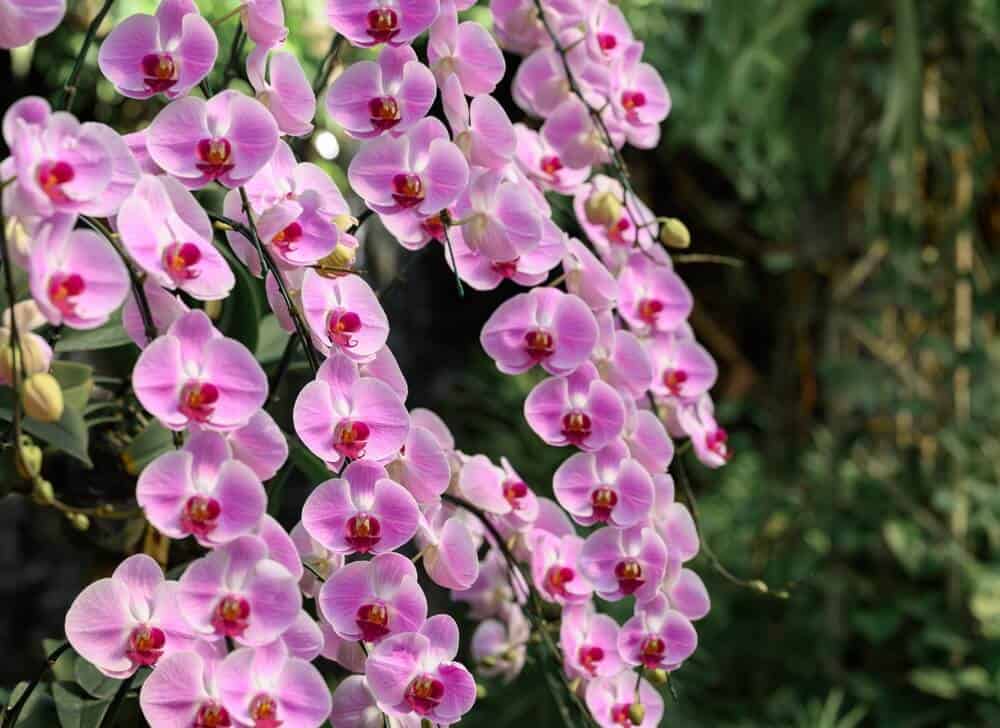Australia is home to thousands of unique flowers — including our fascinating, fabulous native orchids!
Unlike easygoing philodendrons or unfussy succulents, orchids are more demanding in their care needs. Many require consistent moisture and specific growing mediums not just to survive, but to thrive.
Still, the sight of those bright blooms is worth the effort! And don’t worry — even if your orchid goes dormant, it’ll come back during the growing season.
If you’re up for the challenge, here’s a round up of some Australian native orchids and how to care for them.
Types of Orchids | Popular Australian Native Orchids | What Orchids Are Easy to Grow? | Native Orchid Care
List of Australian Orchids
- Boat orchids (Cymbidium)
- Dendrobium
- Dockrillia
- Donkey orchids (Diuris)
- Duck orchids (Caleana)
- Fairy bells (Sarcochilus)
- Greenhoods (Pterostylis)
- Moth orchids (Phalaenopsis)
- Sun orchids (Thelymitra)
Types of Orchids
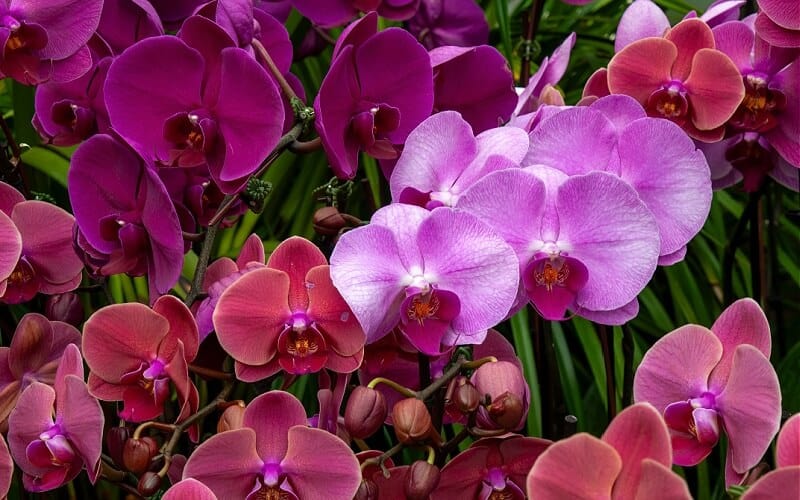
Generally, you can classify orchids into three types — epiphytes, lithophytes, and terrestrials.
The difference comes down to where the plant grows. Knowing the type of orchid ensures it gets the right growing conditions.
Epiphytes
Epiphytes, or epiphytic plants, grow on trees. In the wild, you’ll see them high up, protruding from large trunks and branches.
These plants have aerial roots that attach to trees, allowing them to climb and reach the sunlight. It’s not a parasitic relationship, though — epiphytes are just using the tree as support!
In Australia, most epiphytic orchids can be found along the coast, from the coastal north down to eastern Tasmania.
Many orchids in home gardens are epiphytes, including the popular Dendrobiums.
Lithophytes
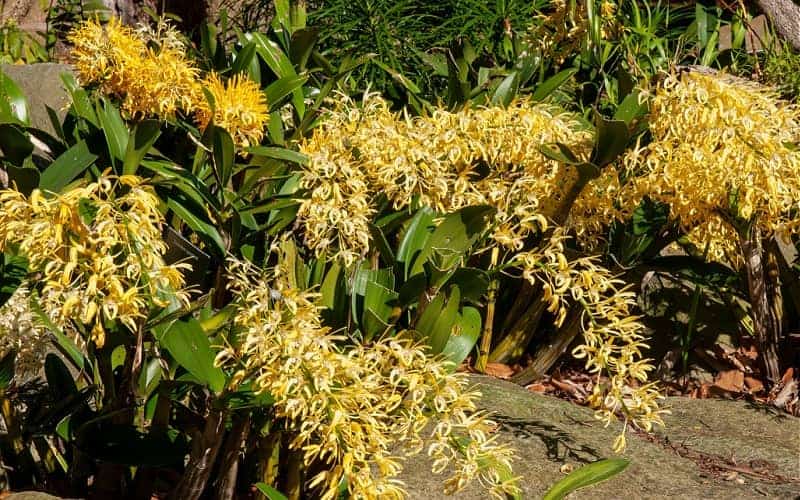
Lithophytic plants grow on the surfaces of rocks and rocky surfaces (like cliffs).
In cultivation and orchid shows, they’re typically grouped with epiphytes since they have similar growing conditions. Both types attach to surfaces and take nutrients from the air and rain around them.
Some species can be both lithophytic and epiphytic!
Terrestrials
Like many other Australian native flowers, terrestrial orchids grow in the ground. They make up almost 75% of all native orchid species in Australia!
Terrestrials typically flower in cool seasons, then die back to an underground tuber or rhizome in hot, dry conditions. The tuber will multiply and regrow in autumn.
Many species do not do well in humid environments, but can tolerate temperatures down to -2ºC.
Popular Australian Native Orchids
Australia has over 1,200 species of orchids, from the ever-popular Dendrobium to the showy Thelymitra.
We can’t name all of them, so we’ve rounded up some crowd favourites among these flowering plants!
Boat orchids (Cymbidium)

Type: Epyphitic or lithophytic
Climate: Temperate and arid
Flowers in: Late winter to spring
Grows in: Mainly NSW, NT, QLD, and WA
Cymbidiums are showy orchids — their fragrant blooms put on a colourful display from August to February. In the wild, you’ll find them up in tree canopies or inside hollows, rooted to decaying wood.
These plants are evergreen, so the leaf bases remain even after the flowers have withered. During the growing season, you’ll get long, arching leaves and brightly-coloured blooms.
A Cymbidium’s foliage can help determine if it’s getting enough light! The leaves are normally light or lime green; if they start darkening, the orchid has too much shade.
Aim for dappled light or partial shade, with some shelter in the afternoon. Use a free-draining growing medium and keep your Cymbidium well-watered in warm weather.
Dendrobium
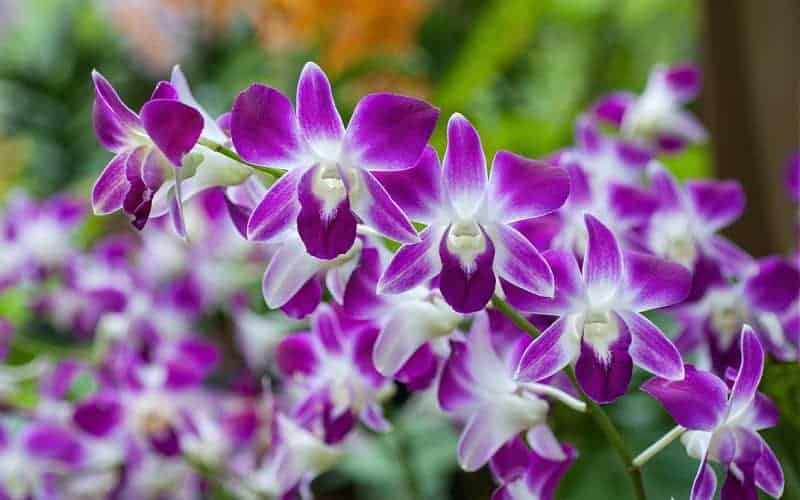
Type: Epyphitic or lithophytic
Climate: Tropical, warm, and temperate
Flowers in: Winter to spring
Grows in: Mainly NSW, QLD, TAS, and VIC
There are nearly 2000 species of Dendrobium orchids, with over 50 endemic to Australia. In fact, Dendrobiums are among the best-known in the country.
Queensland’s floral emblem, for example, is the Dendrobium bigibbum or the Cooktown Orchid. Its arching stems hold plenty of stunning pink-purple blooms, leading to its other nickname — mauve butterfly orchid!
The Australian rock orchid (Dendrobium speciosum) and its cousin, the pink rock lily (Dendrobium kingianum) are widely popular native flowers. They can thrive in most conditions except temps below 2ºC.
Many Dendrobiums are easily cultivated in outdoor gardens. You can even look for hybrids suitable for your local climate.
Dockrillia

Type: Epyphitic or lithophytic
Climate: Tropical and subtropical
Flowers in: Mostly spring
Grows in: Mainly QLD and NSW, some in VIC and TAS
Many Dockrillia orchids used to be classified as Dendrobium, but have since been split off into their own genus. There are about 20 species of Dockrillia native to Australia.
In the wild, Dockrillias are often found growing on tree trunks or cliff faces. They’re endemic to humid forests in Queensland and New South Wales, so don’t typically do well in dry or cool climates.
After the flowering season, expect Dockrillias to go “dormant,” with slowed growth until the following spring. Unlike terrestrials, though, they won’t die back to tubers.
One popular species is the Dockrillia linguiformis or “tongue orchid”! You’ll recognise it by the white or cream flowers with long, narrow petals and the thick, tongue-like leaves.
Donkey orchids (Diuris)
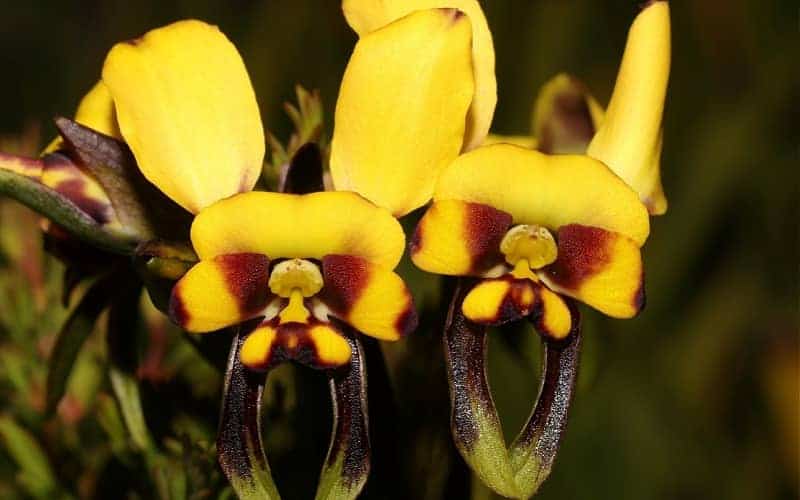
Type: Terrestrial
Climate: Tropical and subtropical
Flowers in: Mostly spring
Grows in: All areas except NT
One look at Diuris flowers and you’ll know why they’re nicknamed “donkey orchids” — they’ve got two large petals that look like donkey ears!
Most Diuris flowers are yellow with a reddish or pinkish blush. They appear in early to mid-spring, after which the orchid goes dormant and dies back to the tuber.
Place Diuris in a well-draining, acidic growing medium. Keep the medium consistently moist in the growing season, but fully dry when the plant is dormant — otherwise, the tubers could rot.
Some species that are easier to care for include Diuris corymbosa and Diuris lanceolata. There’s also Diuris brumalis, or the winter donkey orchid, which flowers in late June around Western Australia!
Duck orchids (Caleana)
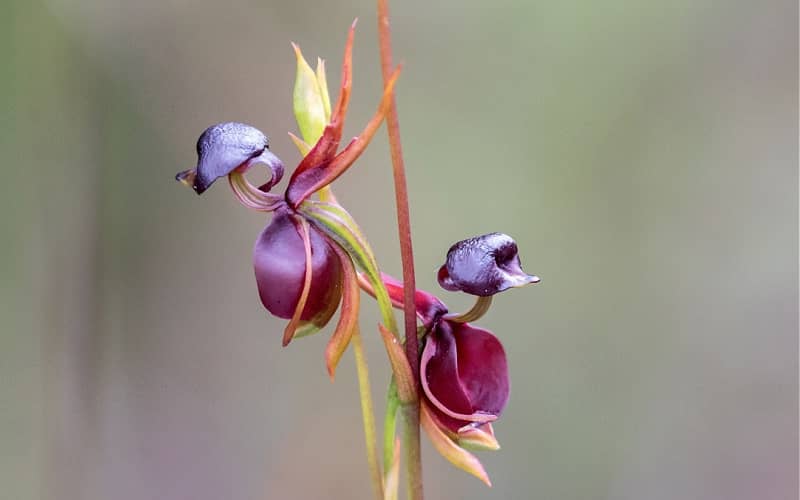
Type: Terrestrial
Climate: Mostly coastal
Flowers in: Mostly spring
Grows in: Eucalyptus woodlands in NSW, QLD, SA, TAS, and VIC
If you’re having a bad day, go look up photos of Caleana major flowers. The flying duck orchid is a favourite among Aussies and can make anyone smile!
Caleanas (or Paracaleanas) are listed as “vulnerable” on conservation lists. They’re typically not available for cultivation since the species relies on two critical factors to survive — sawflies and fungi.
Duck orchids trap sawflies in their duck-shaped flowers for pollination. The flies are attracted to the nectar in the cup, then the “beak” snaps down and covers them in pollen.
Meanwhile, their roots rely on beneficial fungi that only grow in eucalyptus woodlands.
NOTE: Some orchid societies consider Caleanas separate from Paracaleanas, though both are called “duck orchids.”
Fairy bells (Sarcochilus)
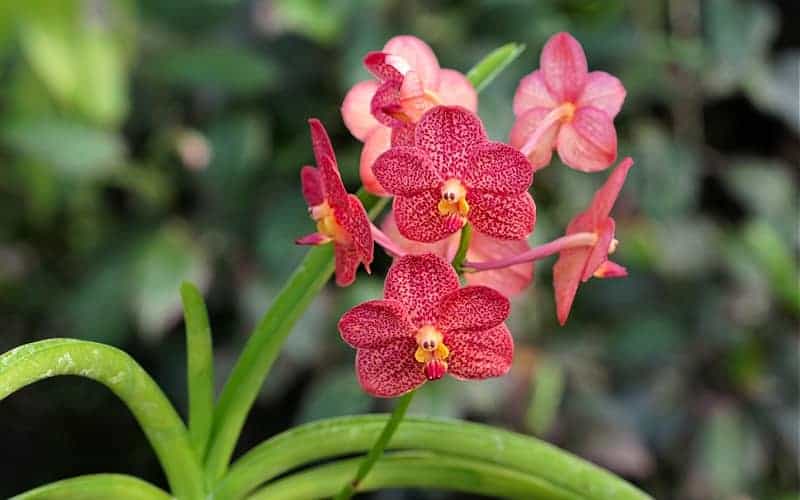
Type: Epiphytic or lithophytic
Climate: Tropical and subtropical
Flowers in: Winter to spring
Grows in: Primarily in eastern regions from QLD to TAS
Don’t confuse Sarcochilus with Caladenias, or fairy orchids — they’re two different genera (groups of species)! Caladenias have long, pointy petals while Sarcochilus has small, rounded petals.
Sarcochilus orchids put out delicate sprays of blooms that arch outwards or cascade down. The petals come in a range of colours, from pink-flecked white to vivid purple.
Fairy bells like humidity and moisture, so keep them well-watered, especially in summer. Keep your plants in partial shade and provide extra protection during very hot or windy weather.
Look for coarse growing mediums that don’t retain too much moisture, which limits the risk of rot. You can also try LECA balls (clay aggregate)!
Greenhoods (Pterostylis)

Type: Terrestrial
Climate: Temperate and coastal
Flowers in: Spring to early summer
Grows in: All areas except NT
Greenhoods have unassuming blooms compared to other orchids — they’re mostly green, though some may have brownish or reddish stripes. They get their name from the “hood” curving over the top.
Pterostylis can grow in a wide range of habitats, from grasslands to rainforests. However, it can struggle in semi-arid, arid, or tropical climates.
In cases of prolonged heat or drought, greenhoods will die back to tubers. They’ll remain dormant until conditions are more ideal.
Greenhoods are one of the easier orchids to grow and care for. They can do well in pots with coarse mediums and regular watering (except when dormant).
Moth orchids (Phalaenopsis)
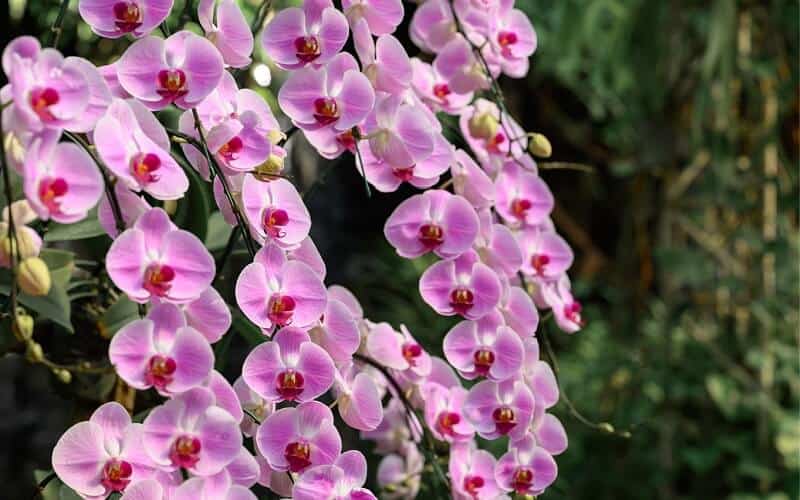
Type: Epiphytic
Climate: Tropical
Flowers in: Summer to autumn
Grows in: QLD
Phalaenopsis orchids are often given as gifts or used as decor, and for good reason! They put out sprays of colourful blooms throughout the year, and some even have funky patterns.
Most Phalaenopsis species are endemic to Asia, but there is one native moth orchid in Australia — Phalaenopsis rosenstromii. It grows in northeast Queensland and is classified as endangered.
P. rosenstromii has white blooms with petals that resemble moth wings. The plant puts out long stems with clusters of flowers near the tip.
Native moth orchids are uncommon in cultivation, but can be available at flower shows or specialist growers. They prefer plenty of humidity, good airflow, and dappled light.
Sun orchids (Thelymitra)
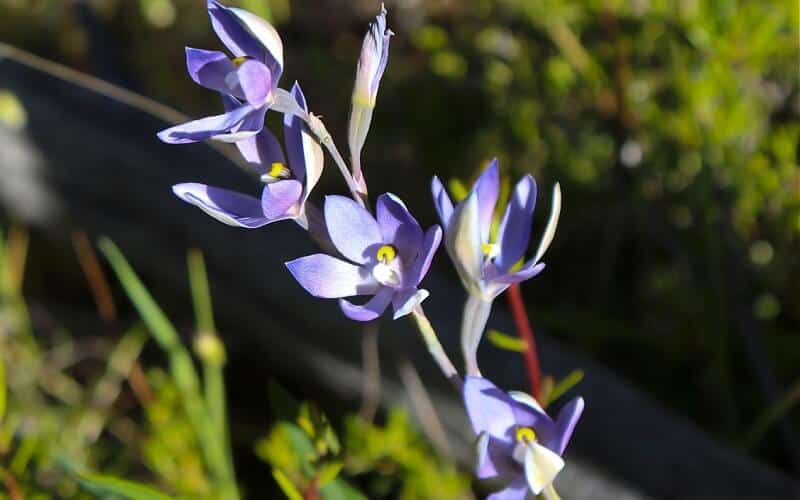
Type: Terrestrial
Climate: Mild tropical and warm temperate
Flowers in: Spring to summer
Grows in: Most areas but mainly NSW, SA, VIC, and WA
Sun orchids take their name from the behaviour of their flowers — they open on hot, sunny days and close or drop off at night! For many species, their blooms won’t open unless the temps are above 22ºC.
Thelymitra blooms come in a wide range of colours, from pale yellow to blue with white striping. Many resemble lilies, allowing the plants to share pollinators.
In cultivation, Thelymitras prefer coarse, free-draining mediums that are slightly acidic. Layer some pine needles over the pot surface to slow down erosion and help retain moisture.
Keep in mind, though, that Thelymitras are difficult to grow outside of their native ranges. Look for small local species — they’re usually easier to care for.
What Orchids Are Easy to Grow in Australia?
Cymbidiums, Dendrobiums, and Dockrillias are among the most adaptable to different climates and are generally recommended for orchid beginners!
However, the type of orchid you grow will largely depend on your local climate and environment. Species from tropical areas will not do well in cool regions, for example, and vice versa.
It’s less challenging to mimic the native habitats of epiphytic and lithophytic orchids, and they’re more adaptable to different climates. However, they require near-daily watering and shade in hotter months.
Terrestrial species are trickier since many rely on beneficial fungi in the wild, and it isn’t easy to recreate those conditions in a regular garden.
Some easy-to-grow Australian native ground orchids include Greenhoods and Diuris.
How to Grow Australian Native Orchids
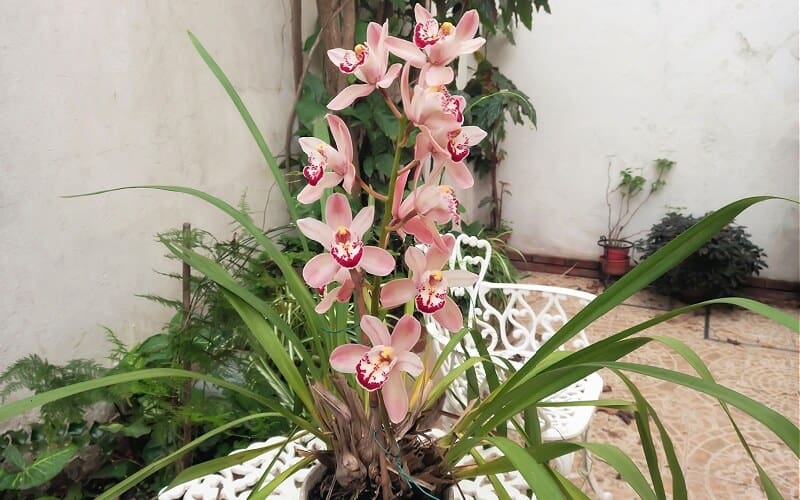
Growing and caring for Australian orchids can feel a bit daunting, since they’re not low-maintenance plants.
Some are adaptable to normal garden conditions, while others have specific care requirements.
Always research your chosen orchid so you can provide the ideal growing environment!
What potting mix should you use for native orchids?
The most important factor when caring for orchids is the growing medium.
Orchid plants aren’t suited to standard houseplant potting mixes. You’ll need a special orchid mix that allows good drainage and contains coarse material like bark chips or gravel — no soil at all.
Most potted orchids will already come in the appropriate mix, so you can keep them in their containers. However, some species — such as Dockrillias — do not do well in pots.
Instead, you’ll have to “naturalise” the plants in your garden by replicating their wild conditions.
Epiphytes can be rooted onto existing trees in your garden, so long as they’re sturdy and don’t lose their bark. Some handy alternatives are wood boards, cork slabs, or old logs.
Lithophytes are perfect for rock gardens, especially when amended with leaf litter or bark mulch.
What are the right growing conditions for native orchids?
Native orchids prefer morning sun and may need partial shade from harsher afternoon sunlight.
In the wild, many orchids grow in the shade of cliffs, rocks, or plants. Epiphytes in particular grow underneath tree canopies.
Keep your plants in a well-ventilated space with plenty of airflow! Be mindful of the weather, though — while orchids are exposed to wind and rain in their natural habitats, too much of either can be harmful.
You can protect outdoor plants with shade cloths or roofs. Alternatively, keep your plants under pergolas or verandahs.
How do you care for Australian orchids?
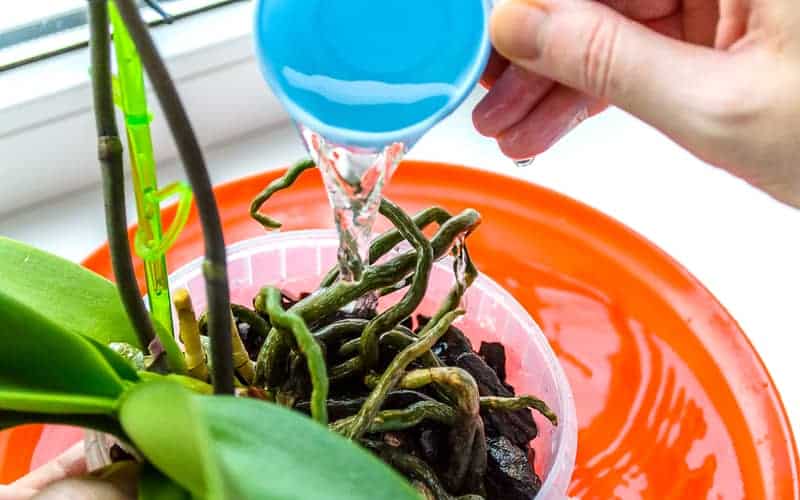
Water your orchids every 1–2 days during the growing season, then scale back to 1–2 times a week in cooler areas or weather (especially winter).
Be mindful of overwatering, though! The growing medium should be uniformly moist, not soggy.
If you live in an area with salt-softened or hard water, use distilled or rainwater for your orchids. They can be sensitive to high mineral content, especially species with fine roots.
For fertiliser, you can give a nitrogen-rich orchid fertiliser during the growing season. Then feed them a weak, slow-release fertiliser after spring flowering.
NOTE: Most orchids are not toxic to pets, but it’s best to prevent licking or ingestion, just in case!
How do you repot an Australian native orchid?
As a general rule, only repot your Aussie native orchid when the plant has severely outgrown the pot or the growing medium has broken down (usually after 3 years).
Many native orchids prefer to be slightly pot-bound — in fact, they often produce more flowers! They’re happy to “crowd” their containers, with roots or growth peeking out.
Should you need to repot your orchid, start by gently wiggling it out of the pot. Try not to disturb the roots, though you can trim any that are stuck to the pot.
(Be warned — if the plant has overcrowded its pot, you may have to break it!)
Use sanitised pruning shears to remove any rotten or damaged growth. You can disinfect the shears with rubbing alcohol, hydrogen peroxide, or methylated spirits.
If you’re just replacing the growing medium, there’s no need to go up a pot size. Only do so if there’s too little space for potting medium alongside the plant.
Once you’ve repotted the orchid, give it a good soak — pot and all — in a container of tepid water. Leave it there for several minutes so the growing medium is fully saturated.
Drain the excess water before returning the plant to its usual spot.

